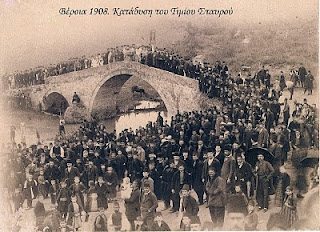~ Για ελληνικά:
Christmas (Kărtŝun) is one of the biggest celebrations of Christianity. Lent Fasting begins on the feast of St. Philip (14 November). Before Christmas Aromanian-Vlach women of Veria, cleaned their houses and made their pastries (sugared buns, revani, baklava, etc.). As Christmas bread, they made ‘Eptazimo’ (ftazmitku pãni), which was a kind of soft and fragrant bread of good quality, made from yeast of chickpea. The housewife worked nearly a day for the bread to be successful (good swelling) and when she was making it, she wanted none next to her because she didn’t anyone to ‘put an evil eye on it’. The truth was that she wanted to prepare it with a lot of attention and proper temperature.
On Christmas Eve (Printu Kãrtŝun) children sang carols (Kolindi) in the houses of relatives and friends. Having small sticks in their hands (tŝumakãts), they banged the door and when the housewife opened for them, they sang: "Kolindi Melindi, den Mai kulaklu, ŝi bãnedzi Paplu, Kã safle Christolu tu pahni al boilãr, di frikã al Uvreilãr = Kolinda Melinda, give a cake to grandmother, for the health of grandfather, because Christ was born in the manger of oxen, from fear of the Jews''.
When they entered the house, they were gaven salt, they threw it in the fireplace, fire began to sparkle and they symbolically wished:
"ŝi dzuakã ezii, zbãndzã nierli, viastili ŝi dzinirats = little goats to dance, health for lambs, brides and grooms''.
Finally, the housewife gave, or threw on the floor dried figs, walnuts, peanuts, candy, etc. (symbolically in the vlachic way the kids were running to catch them like sheep and goats).
On Christmas Eve, they also slaughtered a pig (tilie porkulu). Each house had a well-fed (harnitou) pig, prepared for this purpose. It was fed mostly with corn (katsamaklu ), bran, hot water, salt and it should weigh more than 90 kilos. The slaughtering of the pig was a real rite and it looked like the old sacrifices to the Gods, exclusively with pigs, that did the ancients (Greeks and Latins) did on 17-25 December. More than 3 men needed for the slaughter and the slaughterer should be very experienced. After the slaughter and before skinning, they crossed it to get rid of evil spirits. The housewife with a shovel, a little charcoal and put 'incense, on it and an onion (tsiaprã) in the mouth, then she crossed it and she passed the shovel to all around to all who bent down 3 times in reverence and wished: "Ainte na inti, ma mari” = next year bigger(pig). The children were waiting to get the ‘bubble’ out, e.g the urethra (kiŝitura) because they wanted to use it as a ball to play. All the company fried snacks from the viscera of the animal and drank raki. They slit the pig, they separated (lã bãrtsa) the pieces and hung them.
Next day, they worked it out because the meat was cut easily (as it was cold) and continued eating and drinking. The main food for Christmas Day was‘sarmadz’, which was minced meat wrapped with cabbage (symbolism of the wrapping of the newborn Christ with cloth). ‘Sarmadz’ became more delicious with the addition of pieces of pig fat. All parts of the pig were separated: Fat (pastolou), lean meat (psahnolu), bones with meat (uoŝili ku karni), the side of the animal (plivrets), head (kaplu), feet (tŝuarili) because everything had to be used. Nothing was wasted, even the skin (they used it to make shoes)
The cold (aratsi) fat was cut into pieces, was placed in a cauldron on fire and was melt (tukin) to take the‘ligda’ out (liquid fat), Ligda was used as oil for food throughout the year and was maintained into cans (gazines).What remained were 'tsigarides' ,a very delicious snack.
The Aromanians-Vlachs did not use oil (like all people from mountains) and all the people, in general because oil was expensive. The meat was kippered and kept in a cool place to pieces (no refrigerators). Bones with meat were also kept to make kebabs and ‘kontosuvli’ for the future, the head and the legs for tripe soup The lean meat was good for cooked food and of course was used for the delicious homemade sausages. They sliced it into thin pieces of meat (like minced meat), with spices and pieces of fat, and plugged them into the intestines of the pig (matsãli di porku).
{Source-informants : Tsiamitros Kostas (Psomas), Tsiamitru Basiliki, Tsiamitros E. Yannis (Psomas), Hodradonis Kostas, Kukutegos Yannis, Kukutegos Giorgos, Tsiamitros Antonis (Giantsos) and George Hadzimasuras Giorgos}.
Some words in parentheses are in Aromanian–vlachic idiom, ă = voiceless vowel, ŝ = s thick, by John Tsiamitros, Teacher of traditional dances. Translation in English by John Tsiamitros, too.


Δεν υπάρχουν σχόλια:
Δημοσίευση σχολίου
Η κόσμια κριτική και η ανταλλαγή απόψεων μεταξύ των σχολιαστών είναι σεβαστή. Σχόλια τα οποία υπεισέρχονται σε προσωπικά δεδομένα ή με υβριστικό περιεχόμενο να μην γίνονται. Τα σχόλια αποτελούν καθαρά προσωπικές απόψεις των συντακτών τους. Οι διαχειριστές δεν ευθύνονται σε καμία περίπτωση για τυχόν δημοσίευση υβριστικού ή παράνομου περιεχομένου στα σχόλια των αναρτήσεων.Τα σχόλια αυτά θα διαγράφονται με την πρώτη ευκαιρία.